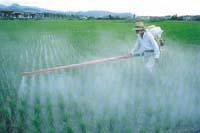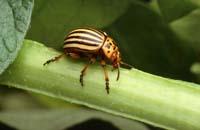Pesticides on the plate
2005/05/08 Galarraga Aiestaran, Ana - Elhuyar Zientzia

According to the Barcelona public health agency, it seems that yes, the consumer can be quite calm in that sense. Within five years, 1,109 foods have been analyzed and in 88.5% no pesticide residues have been found. Otherwise there were remains, but always in concentrations lower than the maximum established by the rules.
On the other hand, depending on the type of pesticides they have detected, almost all were organophosphates. These are more easily eliminated by the human organism than organochlorine, since they dissolve in water. In contrast, organochlorines do not dissolve in water, but accumulate in fat, making them more dangerous in the long run. This is because, despite taking small amounts, their frequent consumption can reach toxic levels, progressively increasing concentration in body fat reserves.
Results of the study
The highest concentrations of pesticides occur in fruits, vegetables, spices and cereals. Vegetable oils and eggs have not detected any positive. Pesticide residues have been detected in different slurries and meats, but in very low concentrations.

Specifically, 28.4% of fruits, 20% of cereals and derivatives, and 7.6% of vegetables have found non-persistent pesticides, a type of pesticide that the body removes. Sustainable pesticides, meanwhile, account for 3.5% of dairy products, 2.4% of vegetables, 1% of cereals, 0.8% of fishery products and 0.3% of meats.
These results do not resemble the study done a few years ago, when it was seen that organochlorine pesticides were widespread. It seems, therefore, that research and regulatory rigor contribute to the health of consumers.
However, researchers who have conducted the study warn that we must be alert. They consider it okay to look at pesticide concentrations in foods at higher risk, but it would be wise to consider how much you eat from each meal. There are foods that are rarely eaten and others that are part of the diet every day. That is why you have to be especially careful with the latter.
Risk of pesticides

The results of the study carried out in Barcelona coincide with those of the controls carried out by the European Union. In general, pesticide residues are within what is permitted by law, without any danger. The rules are so strict because some pesticides have been shown to be harmful to health.
Cereals taken by young children in the bottle or porridge must meet the strictest standards. Pesticides are especially harmful to them. But you don't need to be a young child to intoxicate by pesticides. In fact, sensitivity to pesticides varies considerably from one person to another depending on sex, age and many other characteristics. All this carries the normative rigor just in case. This is called the precautionary principle.
On the other hand, in recent years many consumers have opted for organic, ecological or biological products. There is great confusion with these denominations and often the consumer is unclear what they differ. However, in most cases, buyers of such products look for food produced without pesticides.

However, it may happen that when no pesticide has been used for food production, signs appear in the analyses. Where does that pesticide come from? The answer is simple: from the environment. Some pesticides degrade slowly and persist in the environment. For example, a violent pesticide, DDT, really dangerous to health, has not been used in Euskal Herria since 1977, but is still detected in soil and food. For this reason, organic food producers have special responsibility in cleaning the land and the water of the field.
The pesticides currently used are more selective than the previous ones, that is, they only affect the organism that wants to die. Or at least that's what chemists try. However, pesticides are not the only way to avoid weeds and bugs, but there are other methods: biological, management, mechanical... They are as effective as pesticides used together.
Published in 7K.




